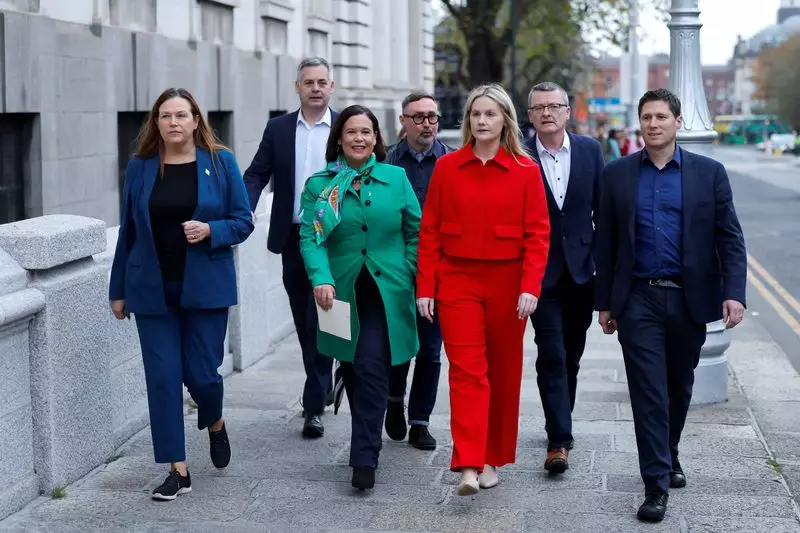In recent months, Sinn Fein has experienced a dramatic reversal in its electoral fortunes, transitioning from a party poised to govern Ireland to struggling to retain relevance in the upcoming elections. Earlier this year, the party seemed on the precipice of reshaping Irish politics, with ambitions to lead both the Republic of Ireland and Northern Ireland, thereby significantly advancing the cause of Irish reunification. However, this aspiration appears now to be diminishing, primarily due to fractures within the party’s core support base. The fallout stems largely from growing discontent among traditional working-class voters, who have reacted negatively to Sinn Fein’s progressive stance on immigration, leading many to reassess their loyalty.
The impending election on November 29 presents a crucial moment as Sinn Fein looks to recover its footing. The ambition of establishing a dedicated minister for reunification seems increasingly remote, as the voices advocating for such a movement have weakened. Political experts and commentators on the Irish political landscape suggest that a decline in public support for Sinn Fein could stifle, at least temporarily, the discussions that would potentially culminate in a referendum on Irish unification.
Colin Harvey, a respected authority on human rights law, encapsulated the challenges faced by Sinn Fein and the broader nationalist movement when he stated that the journey toward reunification requires a collective political effort. He emphasizes that Sinn Fein, while pivotal, cannot shepherd this vision alone. Instead, a broad coalition—including various political parties and civic groups—must emerge to advocate for a unified Ireland proactively. However, as the current political atmosphere suggests, there is little evidence that such a coalition is gaining momentum in the lead-up to this election cycle.
During a recent canvass in Dublin’s working-class neighborhoods, conversations steered towards immediate concerns like housing affordability and the perceived inadequacies of public services rather than discussions of political reunification. This shift in focus, highlighted by the sentiments of young voters grappling with contemporary economic pressures, underscores a significant disconnect between the traditional goals of Sinn Fein and the pressing issues faced by younger constituents.
Competing political forces like Fine Gael and Fianna Fail, Sinn Fein’s historical adversaries, have not found it prudent to prioritize the call for reunification in their election strategies. These parties, while acknowledging the topic in vague terms, have largely sidelined the issue of Northern Ireland’s status in their campaign platforms. Fine Gael’s extensive election manifesto offers scant attention, perhaps a testament to the cautious approach they prefer, advocating instead for gradual engagement supported by substantial investment in the Northern Irish economy.
Interactions among mainstream parties have shown a reluctance to collaborate with Sinn Fein, even as the nationalist sentiment appears to resonate with a segment of the population. Polls indicate that Fine Gael and Fianna Fail may once again secure a majority, leaving Sinn Fein sidelined and unable to influence the overarching narrative for the incoming government.
Despite the fluctuating dynamics in party popularity, public sentiment regarding reunification remains complex. There is a notable majority in the Republic of Ireland favoring the dissolution of British authority in Northern Ireland. Nonetheless, a substantial portion of the Northern Irish populace has resisted these calls, revealing a complex tapestry of opinions shaped by socioeconomic factors and historical contexts. The perceived viability of unity has fluctuated, particularly in light of recent developments surrounding Brexit, which have reignited discussions about national identity and regional governance.
Data from the 2021 census indicates a demographic shift where the number of Catholics, traditionally more inclined toward supporting a united Ireland, surpasses that of Protestants for the first time. This transformation could suggest a gradual change in the political landscape, potentially influencing future discourse around unity.
Sinn Fein’s current predicament showcases the volatility of political allegiance, but their leaders maintain an unwavering focus on the ultimate goal of reunification. Mary Lou McDonald, the party leader, has articulated a firm commitment to placing the issue at the forefront of governmental discourse. Nevertheless, the transition from political aspiration to tangible reality requires not only vision but also strategic collaboration among varied stakeholders within the Republic and Northern Ireland. The concept of an Irish unification referendum is enshrined within the parameters of the 1998 Good Friday Agreement, ensuring it remains a possibility, albeit a complex one.
While the immediate electoral prospects for Sinn Fein appear less favorable, the overarching movement for Irish unity retains its significance. The challenge going forward will be how to navigate the political landscape amidst shifting voter priorities, ensuring that the quest for a united Ireland evolves beyond party politics into a shared societal goal. The upcoming election may prove pivotal in determining the next steps for Irish nationalism and the potential for meaningful discourse around reunification.

